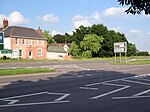Sharnford
BlabyCivil parishes in LeicestershireLeicestershire geography stubsUse British English from February 2022Villages in Leicestershire

Sharnford is a village and civil parish in Blaby of Leicestershire. The parish has a population of about 1,000, measured at the 2011 census as 985. The village is about four miles east of Hinckley, and is near to Aston Flamville, Wigston Parva and Sapcote.
Excerpt from the Wikipedia article Sharnford (License: CC BY-SA 3.0, Authors, Images).Sharnford
Leicester Road,
Geographical coordinates (GPS) Address Nearby Places Show on map
Geographical coordinates (GPS)
| Latitude | Longitude |
|---|---|
| N 52.52122 ° | E -1.29474 ° |
Address
Leicester Road 15,17
LE10 3PH , Sharnford
England, United Kingdom
Open on Google Maps







